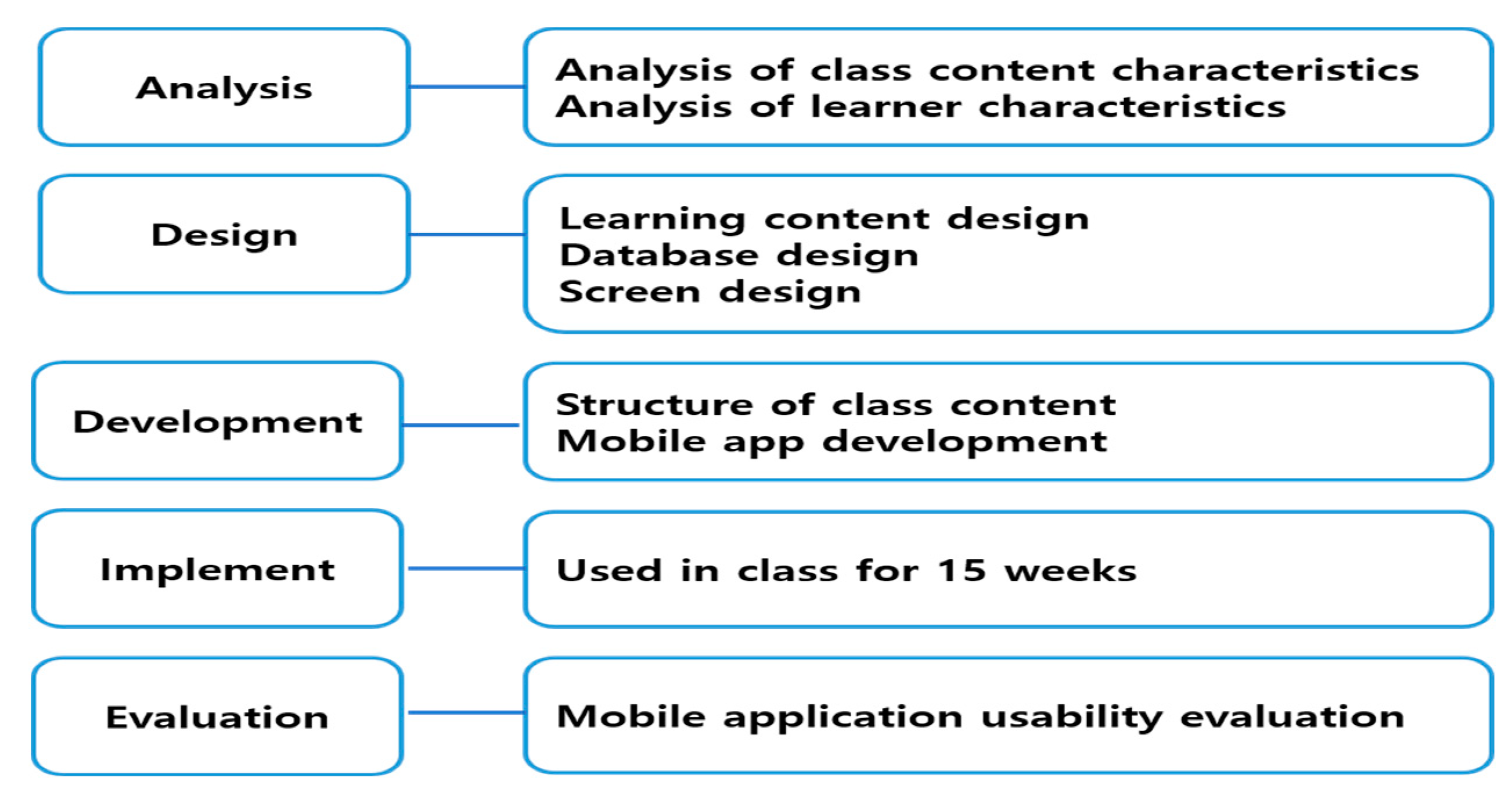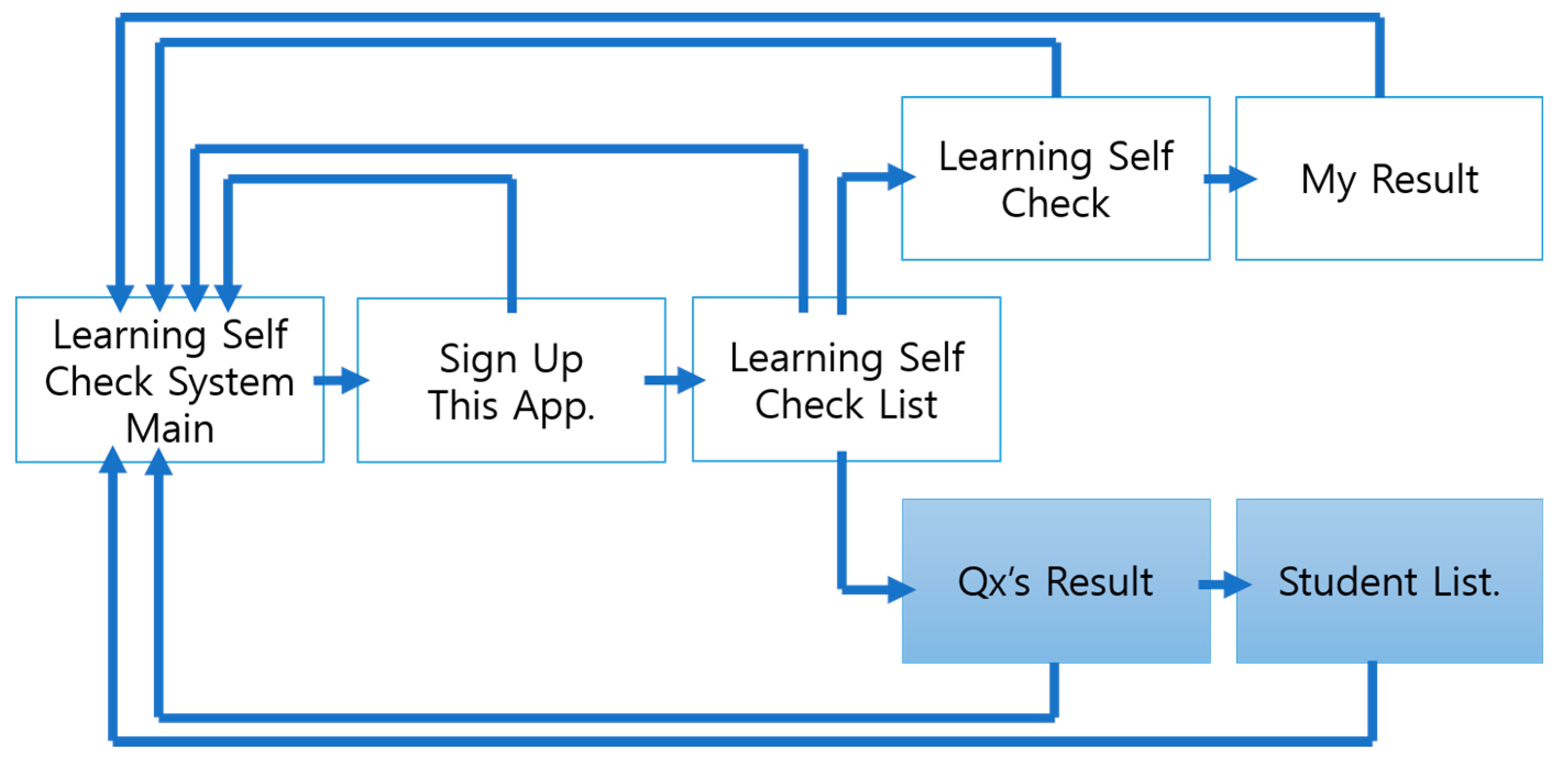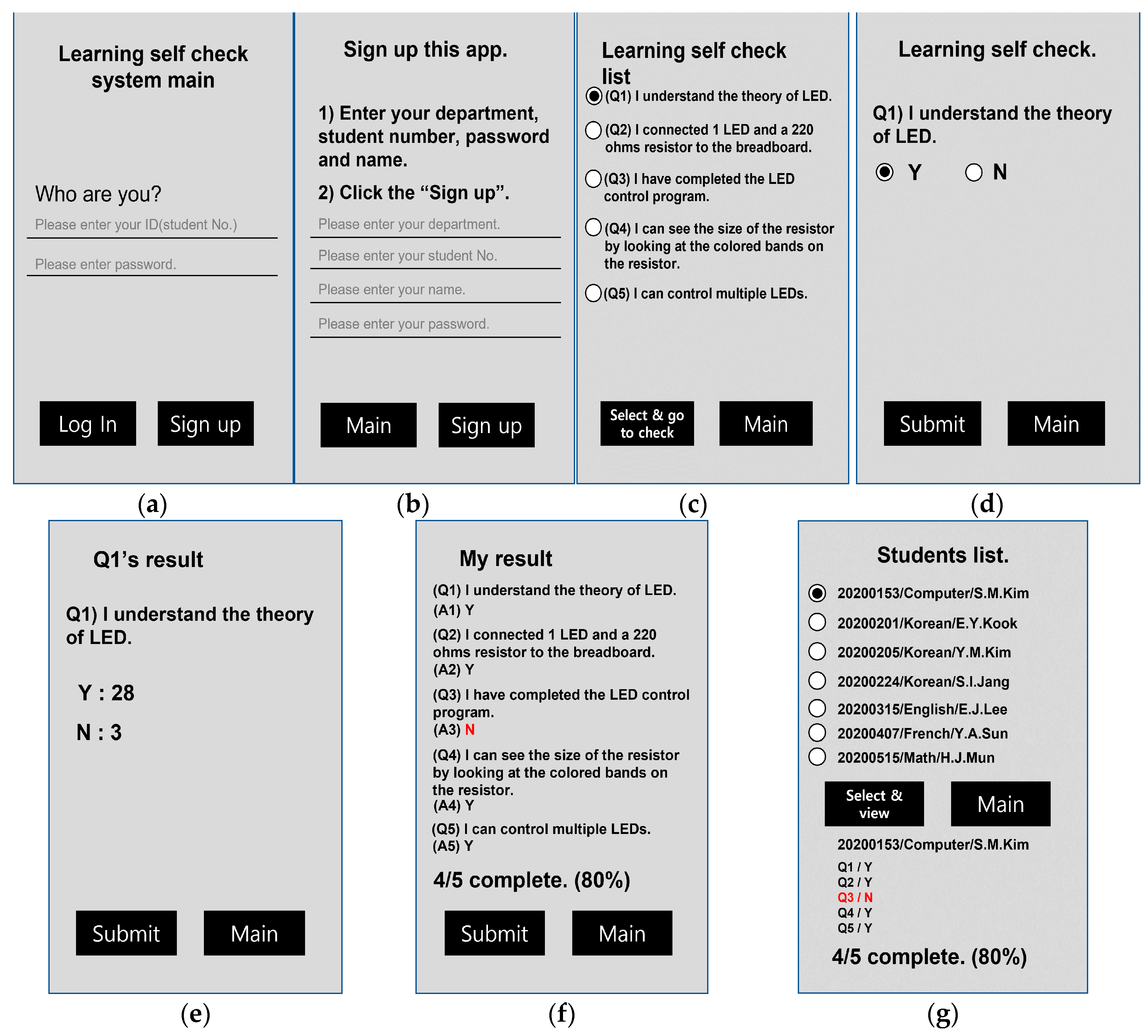Design and Development of a Self-Diagnostic Mobile Application for Learning Progress in Non-Face-to-Face Practice Learning
Abstract
:1. Introduction
2. Related Works
2.1. Non-Face-to-Face (Non-F2F) Learning
2.2. Mobile Application Usability Evaluation
3. Research Process
3.1. Subjects of Research
3.2. Method of Research
3.2.1. ADDIE Model
3.2.2. Research Tools
4. Results of Research
4.1. Analysis
4.2. Design
4.2.1. Database Design
4.2.2. Menu Structure Design
4.3. Development
4.3.1. Learning Contents Development
4.3.2. Implementation of a Mobile Application for Self-Diagnosis of Learning Progress
4.4. Implement
4.5. Evaluation
5. Conclusions and Discussion
Author Contributions
Funding
Institutional Review Board Statement
Informed Consent Statement
Conflicts of Interest
References
- Demuyakor, J. Coronavirus (COVID-19) and Online Learning in Higher Institutions of Education: A Survey of the Perceptions of Ghanaian International Students in China. Online J. Commun. Media Technol. 2020, 10, e202018. [Google Scholar] [CrossRef]
- Avgerinou, M.D.; Moros, S.E. The 5-Phase Process as a Balancing Act during Times of Disruption: Transitioning to Virtual Teaching at an International JK-5 School; Teaching, Technology, an Teacher Education during the COVID-19 Pandemic: Stories from the Field; Association for the Advancement of Computing in Education (AACE): Waynesfield, NC, USA, 2020; pp. 583–589. Available online: https://media-acs.zentech.gr/filesystem/Multimedia/pdf/Pages_from_ebook_online_teaching_and_learning-2_id393.pdf (accessed on 28 September 2020).
- Shin, Y.-J.; Lee, H.-J.; Kim, J.-H.; Kwon, D.-Y.; Lee, S.-A.; Choo, Y.-J.; Park, J.-H.; Jung, J.-H.; Lee, H.-S.; Kim, J.-H. Non-face-to-face online home training application study using deep learning-based image processing technique and standard exercise program. J. Converg. Cult. Technol. (JCCT) 2021, 7, 577–582. [Google Scholar] [CrossRef]
- Kim, J.S.; Ahn, Y.J.; Kim, K.A. Analysis of Presence Impacting on Learning Satisfaction and Persistence in Non-face-to-face Programming Courses. In Proceedings of the Korean Society of Computer Information Conference, Busan, Korea, 21–23 January 2021; Volume 29, pp. 303–304. [Google Scholar]
- Wang, C.; Hsu, H.-C.K.; Bonem, E.M.; Moss, J.D.; Yu, S.; Nelson, D.B.; Levesque-Bristol, C. Need satisfaction and need dissatisfaction: A comparative study of online and face-to-face learning contexts. Comput. Hum. Behav. 2019, 95, 114–125. [Google Scholar] [CrossRef]
- Lee, Y. A study on the Correlation of between Online Learning Patterns and Learning Effects in the Non-face-to-face Learning Environment. J. Korea Acad.-Ind. Coop. Soc. 2020, 21, 557–562. [Google Scholar] [CrossRef]
- Jeon, S.J.; Yoo, H.H. Relationship between General Characteristics, Learning Flow, Self-Directedness and Learner Satisfaction of Medical Students in Online Learning Environment. J. Korea Contents Assoc. 2020, 20, 65–74. [Google Scholar] [CrossRef]
- Wallace, P.E.; Clariana, R.B. Achievement Predictors for a Computer-Applications Module Delivered Online. J. Inf. Syst. Educ. 2000, 11, 13–18. [Google Scholar]
- Zhao, Y.; Tang, Y.; Liu, F.; Peng, Z.; Kong, J.; Huang, J.; Tong, Z. Research and practice of online emergency teaching based on electronic information technology under the influence of COVID-19. Int. J. Electr. Eng. Educ. 2021, 0020720920985048. [Google Scholar] [CrossRef]
- Gandraß, N.; Hinrichs, T.; Schmolitzky, A. Towards an Online Programming Platform Complementing Software Engineering Education. 2020, pp. 27–35. Available online: http://ceur-ws.org/Vol-2531/paper05.pdf (accessed on 17 September 2021).
- Koretsky, M. Work-in-Progress: An Online Journal Tool with Feedback for a Learning Assistant Program in Engineering. In Proceedings of the ASEE’S Virtual Conference, Virtual Online, 22–26 June 2020. [Google Scholar] [CrossRef]
- Park, H. A Study on the Online Software Education Model Based on Arduino. Master’s Thesis, Woosong University, Daejeon, Korea, 2020. Available online: http://www.riss.kr/link?id=T15593957 (accessed on 17 September 2021).
- Gorchs-Font, N.; Ramon-Aribau, A.; Yildirim, M.; Kroll, T.; Larkin, P.J.; Subirana-Casacuberta, M. Nursing students’ first experience of death: Identifying mechanisms for practice learning. A realist review. Nurse Educ. Today 2021, 96, 104637. [Google Scholar] [CrossRef] [PubMed]
- Renfrew, M.J.; Bradshaw, G.; Burnett, A.; Byrom, A.; Entwistle, F.; King, K.; Olayiwola, W.; Thomas, G. Sustaining quality education and practice learning in a pandemic and beyond: “I have never learnt as much in my life, as quickly, ever”. Midwifery 2021, 94, 102915. [Google Scholar] [CrossRef] [PubMed]
- Gena, C.; Mattutino, C.; Cellie, D.; Di Ninno, F.; Mosca, E. Teaching and learning educational robotics: An open source robot and its e-learning platform. In Proceedings of the FabLearn Europe/MakeEd 2021—An International Conference on Computing, Design and Making in Education, St. Gallen, Switzerland, 2–3 June 2021; pp. 1–4. [Google Scholar]
- Alharbi, F. Integrating internet of things in electrical engineering education. Int. J. Electr. Eng. Educ. 2020, 0020720920903422. [Google Scholar] [CrossRef]
- Yang, J. Quiz Management System for Mobile Web-Based Learning Environment. Master’s Thesis, Ewha Womans University, Seoul, Korea, 2018. Available online: http://www.riss.kr/link?id=T14881185 (accessed on 17 September 2021).
- Kim, E. Effects of Self-Directedness Computer Efficacy and Learning Strategy of High School Students on E-Learing Outcome. Master’s Thesis, Yonsei University, Seoul, Korea, 2014. Available online: http://www.riss.kr/link?id=T13455036 (accessed on 17 September 2021).
- Kang, M.H.; Kim, N.Y.; Kim, M.J.; Kim, J.Y.; Lim, H.J. A structural relationship among teaching presence, learning presence and learning outcomes of e-Learning in Cyber University. J. Educ. Inf. Media 2011, 17, 153–176. [Google Scholar]
- Lee, J.-M.; Yoon, S.-I. The Effects of Task Value, Perceived Usefulness, and Teaching Presence on Learning Outcomes in Cyber University. J. Korean Assoc. Inf. Educ. 2011, 15, 449–458. [Google Scholar]
- Park, J.; Kim, S. Analysis of Influencing Factors of Learning Engagement and Teaching Presence in Online Programming Classes. J. Inf. Commun. Converg. Eng. 2020, 18, 239–244. [Google Scholar] [CrossRef]
- Jialiang, H.; Huiying, Z. Mobile-based education design for teaching and learning platform based on virtual reality. Int. J. Electr. Eng. Educ. 2020, 0020720920928547. [Google Scholar] [CrossRef]
- Chen, W.; Jeong, S.; Jung, H. WiFi-Based home IoT communication system. J. Inf. Commun. Converg. Eng. 2020, 18, 8–15. [Google Scholar] [CrossRef]
- Hong, S. Technology trends and policies for IoT security. Int. J. Emerg. Multidiscip. Res. (IJEMR) 2020, 4, 1–6. [Google Scholar] [CrossRef]
- Wang, E. Improving Interface Usability of Mobile E-Commerce Augmented Reality (AR) Contents. Master’s Thesis, Yonsei University, Seoul, Korea, 2021. Available online: http://www.riss.kr/link?id=T15732039 (accessed on 17 September 2021).
- Lee, W.W.; Owens, D.L. Multimedia-Based Instructional Design: Computer-Based Training, Web-Based Training, Distance Broadcast Training, Performance-Based Solutions; Pfeiffer: San Francisco, CA, USA, 2004; ISBN 9780787970697. [Google Scholar]
- Jones, B.A. ADDIE Model (Instructional Design). 2014. Available online: http://citeseerx.ist.psu.edu/viewdoc/summary?doi=10.1.1.572.4041 (accessed on 17 September 2021).
- Davis, A.L. Using instructional design principles to develop effective information literacy instruction: The ADDIE model. Coll. Res. Libr. News 2013, 74, 205–207. [Google Scholar] [CrossRef]
- Wang, S.-K.; Hsu, H.-Y. Using ADDIE model to design Second Life activities for online learners. In Proceedings of the Association for the Advancement of Computing in Education (AACE), Las Vegas, NV, USA, 17 November 2008; pp. 2045–2050. Available online: https://www.learntechlib.org/primary/p/29946 (accessed on 17 September 2021).
- Jung, C.W. Smartphone App Feasibility Test for Activity Daily Living Education in Stroke Patients. Master’s Thesis, Honam University, Gwangju, Korea, 2018. Available online: http://www.riss.kr/link?id=T14730924 (accessed on 17 September 2021).




| Wide Scope Unit | Detail Scope Unit | Number of Question Items |
|---|---|---|
| Contents | Accuracy | 2 |
| Understanding | 3 | |
| Objectivity | 4 | |
| Total of Contents | 9 | |
| Interface’s Design | Consistency | 3 |
| Design suitability | 5 | |
| Vocabulary accuracy | 3 | |
| Total of Interface’s Design | 11 | |
| Technology | Security | 2 |
| Total | 22 | |
| Weeks | Wide Scope Unit | Detail Scope Unit |
|---|---|---|
| 1 | Orientation and Arduino’s elements | |
| 2 | Output parts and circuits | Tinkercad, App Inventor and LED output |
| 3 | Bluetooth connect, aia project file, using components | |
| 4 | Common cathode, common anode, RGB LED output and mobile control | |
| 5 | Servo motor output and mobile control | |
| 6 | Resistance size, piezo speaker output and mobile control | |
| 7 | Motor driver, DC motor output and mobile control | |
| 8 | Middle test project maker and presentation | |
| 9 | Input parts and circuits | FND and LCD output and mobile control |
| 10 | Ultrasonic sensor input and mobile control | |
| 11 | Temperature and humidity sensor input and mobile control | |
| 12 | Variable resistance and joystick input and mobile control | |
| 13 | PIR sensor input and mobile control | |
| 14 | Photoresist sensor input and mobile control | |
| 15 | Final test project maker and presentation | |
| Table’s Name | Field’s Name | Data Type | Example |
|---|---|---|---|
| studentTBL | student_Number (primary key) | Integer | 20200001 |
| student_Name | Text | Gildong Hong | |
| student_Password | Text | hgd1234!! | |
| questionTBL | student_Number (foreign key) | Integer | 20200001 |
| question_Number | Integer | 1 | |
| question_Text | Text | I understood the teacher’s explanation. | |
| answer_YorN | Text | Y/N | |
| complete_Percent | Integer | 100% | |
| yes_Persons | Integer | 100 | |
| no_Persons | Integer | 0 |
| Wide Scope Unit | Detail Scope Unit | Contents | Mean | SD |
|---|---|---|---|---|
| Mobile contents | Accuracy | Learning-related information is reliable. | 4.22 | 0.93 |
| Learning-related information is clear. | 4.28 | 0.74 | ||
| Total of accuracy | 4.25 | 0.83 | ||
| Understandability | Easy to understand learning-related information. | 4.25 | 0.77 | |
| Learning-related terms are familiar to me. | 4.22 | 0.80 | ||
| Learning-related information level is easy to understand even in the early stages of learning. | 4.11 | 0.78 | ||
| Total of understandability | 4.19 | 0.78 | ||
| Objectivity | Learning-related information has specialty. | 4.06 | 0.95 | |
| Learning-related information is systematic and specific. | 3.97 | 0.97 | ||
| Learning-related information is provided by an authoritative institution. | 3.94 | 0.98 | ||
| Suitable for providing information with specialized knowledge of learning content. | 4.36 | 0.72 | ||
| Total of objectivity | 4.08 | 0.92 | ||
| Interface design | Consistency | There is consistency in color, arrangement, and expression method. | 4.19 | 0.86 |
| The arrangement of icons in the mobile application is now unified with the overall design. | 4.19 | 0.89 | ||
| The icons in the mobile application are grouped together for consistency. | 4.22 | 0.80 | ||
| Total of consistency | 4.20 | 0.84 | ||
| Design suitability | Arrange the content for gradually access and make it logically easy to understand. | 4.06 | 0.95 | |
| The meaning of the icon was clearly expressed. | 4.14 | 0.83 | ||
| The characters used in the mobile application are in a size and font that are easy for the viewer to read. | 4.42 | 0.81 | ||
| The visual elements work comfortably on the user. | 4.03 | 0.74 | ||
| You can grasp the structure of mobile applications at a glance. | 3.97 | 0.94 | ||
| Total of design suitability | 4.12 | 0.86 | ||
| Vocabulary accuracy | The phrases used in the mobile application are concise. | 4.06 | 0.83 | |
| The phrase used in the mobile application is accurate. | 4.22 | 0.76 | ||
| The phrase used in the mobile application is correct. | 4.19 | 0.79 | ||
| Total of vocabulary accuracy | 4.16 | 0.79 | ||
| Technology | Security | Information on personal information protection was presented. | 3.92 | 1.00 |
| Presented a security policy for learning-related personal information. | 3.53 | 1.18 | ||
| Total of security | 3.72 | 1.10 |
Publisher’s Note: MDPI stays neutral with regard to jurisdictional claims in published maps and institutional affiliations. |
© 2021 by the authors. Licensee MDPI, Basel, Switzerland. This article is an open access article distributed under the terms and conditions of the Creative Commons Attribution (CC BY) license (https://creativecommons.org/licenses/by/4.0/).
Share and Cite
Kim, S.; Mun, H.-J. Design and Development of a Self-Diagnostic Mobile Application for Learning Progress in Non-Face-to-Face Practice Learning. Appl. Sci. 2021, 11, 10816. https://doi.org/10.3390/app112210816
Kim S, Mun H-J. Design and Development of a Self-Diagnostic Mobile Application for Learning Progress in Non-Face-to-Face Practice Learning. Applied Sciences. 2021; 11(22):10816. https://doi.org/10.3390/app112210816
Chicago/Turabian StyleKim, Semin, and Hyung-Jin Mun. 2021. "Design and Development of a Self-Diagnostic Mobile Application for Learning Progress in Non-Face-to-Face Practice Learning" Applied Sciences 11, no. 22: 10816. https://doi.org/10.3390/app112210816
APA StyleKim, S., & Mun, H.-J. (2021). Design and Development of a Self-Diagnostic Mobile Application for Learning Progress in Non-Face-to-Face Practice Learning. Applied Sciences, 11(22), 10816. https://doi.org/10.3390/app112210816







